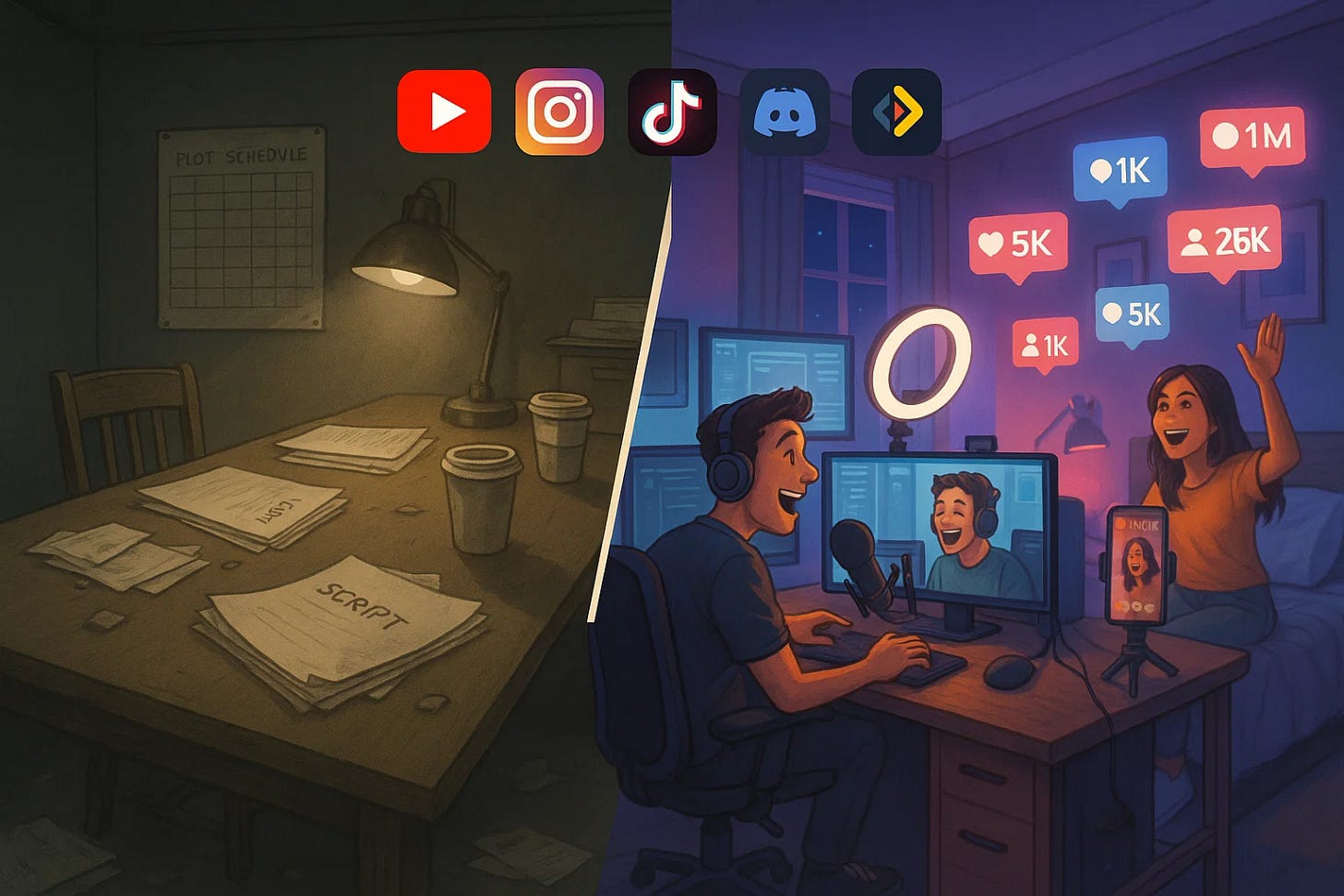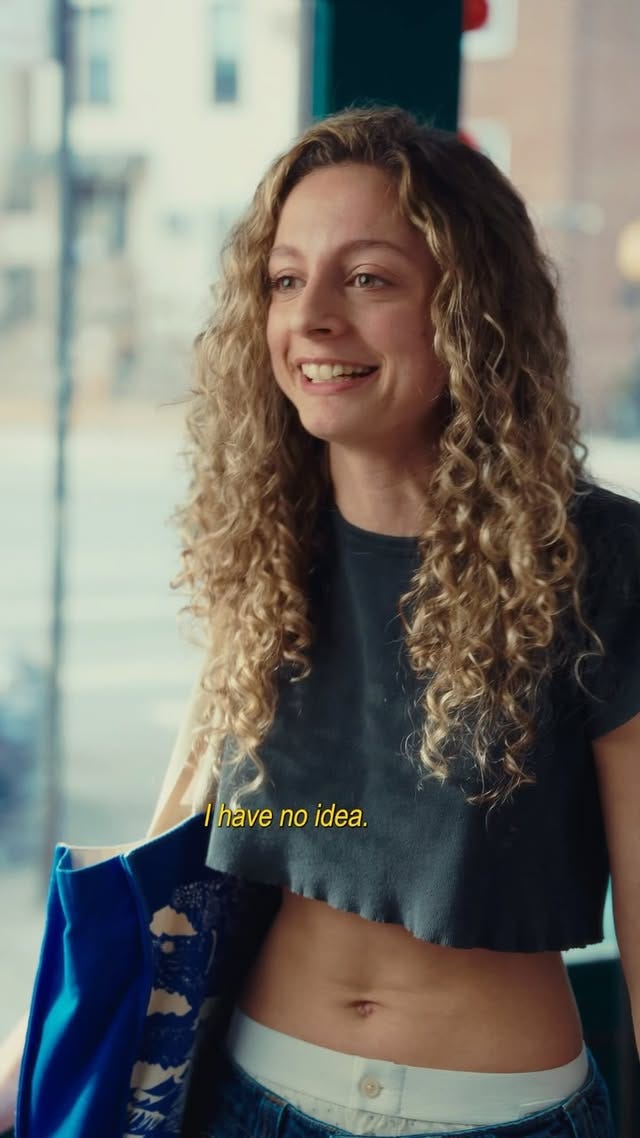I grew up in the era of legacy comedy dominance.
Billy Madison, Happy Gilmore, Zoolander, Meet The Parents, Wedding Crashers and The 40 Year Old Virgin were favorites of my adolescence. Let’s not forget The Fox comedy lineup of The Simpsons, That 70’s Show, Family Guy and King of the Hill. There were also plenty of others like The League, It’s Always Sunny In Philadelphia, VEEP and Arrested Development.
These were pieces of comedy that formed my very specific palate. That and the likes of Ralphie May, Bernie Mac, Ron White, Norm Macdonald, George Carlin and Greg Giraldo. They helped forge a die hard comedy fan that in recent years has found that this genre of content is rarely found in the places I used to find it.
My dream as an aspiring writer was to one day work in a comedy writer's room and concoct jokes all day on the lot at some studio in Hollywood.
Those days are long gone. That type of work environment is hard to find, especially for an up and coming writer.
So where do I get my fix?
Not in the theatre, but online. It's not Thursday night on a major network, it's a weekly drop on Instagram or YouTube.
And I'm not alone. The entire comedy ecosystem has migrated while the studios were still scheduling pilot season.
The industry claims comedy in theaters is back, or at least 'Friendship' and 'The Naked Gun' are making a strong case for that argument. Netflix's 'Happy Gilmore 2' just crushed it with 41 million views in week one.
But here's what nobody's talking about: Brooklyn Coffee Shop pulled 8 million views with their first episode.
Major streaming comedies burn $2-5 million per episode for half that audience.
The game has already changed. While we're debating whether digital counts as 'real' comedy, creators are building empires from their bedrooms.
Web-to-TV That Actually Works
Forget everything you think you know about "maintaining authenticity." The real secret is platform fluidity and letting content exist in different states simultaneously.
Take Tires on Netflix.
Shane Gillis self-financed the first season from 'Gilly & Keeves’ then sold it to Netflix for a speculated $5 million. Now it exists as three different experiences:
For podcast fans: Gillis's comedy universe
For Netflix browsers: workplace comedy
For comedy purists: proof transgressive humor still has mainstream appeal
Gillis didn't port his show to Netflix. He let it live multiple lives at once.
Dreaming Whilst Black went from 500K YouTube views to 2.3 million on BBC Three. How? They added workplace storylines for broad appeal while keeping cultural specificity intact.
How To With John Wilson transformed 50-100K Vimeo views into 800K-1M HBO viewers. The secret? Filming 200+ hours per episode. Maintaining obsessive documentary style within TV constraints.
Want to know what doesn't work?
Comedy Central's 'High School USA!' died after one season despite 15 million web subscribers. They stretched 11-minute episodes to 22 minutes. Destroyed the pacing. Dead on arrival.
The lesson is mathematical: successful transition requires understanding how platforms metabolize content differently.
Content That Multiplies Itself
Your primary series is just the foundation. The real money lives in the shadow economy of complementary content.
Shanked gets this.
The cast members are comedians and creators in their own right. By leveraging their existing communities and sharing BTS moments from Shanked across their own channels, they create an ecosystem that can generate more total engagement than the episodes themselves.
Smosh turned this into science. One shooting day becomes:
Main sketch (3-5M views)
Try Not to Laugh (8-10M)
Behind-the-scenes (1-2M)
Podcast (500K downloads)
Livestreams (2-3M)
TikTok clips (10-15M)
Annual revenue: $15-20M versus $3-4M if they only produced main content.
That's a 5x multiplier.
Good Mythical Morning built a $30M annual business where the main show is the smallest revenue generator. 10 billion total views. Only 40% from main episodes.
Reaction videos alone generate tons of additional annual views.
They let the shadow economy thrive because it's worth more than the primary economy.
Sketches as Live Ammunition
Forget focus groups. The new model uses sketches as market testing in real-time.
Traditional pilot: $2-5M for one concept. Digital testing: $10-50K for 50-100 concepts.
Brian Jordan Alvarez proved it. Three years testing characters on TikTok. $15,000 total spend. His character videos pulled 200M+ views, creating massive data sets on what worked.
Result? 'English Teacher' premiered to 2.3M viewers. FX's strongest comedy launch in five years.
The network saved millions while getting pre-validated content.
Caleb Hearon turned Twitter into a development lab:
500+ comedic bits over two years
Bits exceeding 100K views became sketches
Sketches topping 1M views became series concepts
Traditional development could cost $500K in market research. Hearon did it for free while building an audience.
Superwog discovered through YouTube data:
Family sketches outperformed friend sketches by 300%
Ethnic humor traveled globally, Australian-specific didn't
Sub-3-minute sketches had 80% completion versus 45% for longer content
When ABC Australia commissioned their series, it came pre-optimized based on 100M+ views of data.
Meanwhile, Quibi burned $1.75 billion on content nobody validated.
Your development budget should be 90% testing, 10% production. Not the reverse.
Fan Economies You Don't Own
Stop trying to control your fan base. Cultivate it instead.
KallMeKris seeds 3-4 "duet-able" moments per video. Each original spawns 100-200 fan remixes. That's 10-20M additional impressions per video.
Her 50M followers are an unpaid marketing department generating $2-3M in equivalent advertising value monthly.
RDCWorld1 built Dream Con from online sketches. The convention generated $3M in ticket sales. But the real value? 50M+ impressions of user-generated content.
Fans pay to create marketing for them.
Gus Johnson tracks which moments get remixed most. Creates similar content. When he releases a 2M-view sketch, fan content generates another 5-8M views.
Want to know how to kill this golden goose?
Fine Brothers tried to trademark "React" videos. Lost 675,000 subscribers in one week.
You don't own your fan economy. You cultivate it.
Worlds That Generate Revenue
This isn't merchandising. It's fictional worlds becoming real economies.
Viva La Dirt League raised $3.2M crowdfunding. Backers didn't just donate – they bought into a universe:
Become NPCs in their world
Have items named after them
Join exclusive game servers
Their Baelin's Route film generated $500K direct sales plus $2M in channel growth.
JK! Studios' Freelancers secured $300K fan investment with equity participation. ROI for early investors: 250% over two years.
Aunty Donna built a multi-tentacle business:
YouTube: 100M+ views
Netflix: $1M+ deal
Live tours: $2M annually
Podcast: $500K annually
Merchandise: $300K annually
The math is beautiful: Podcast listeners are 3x more likely to buy tickets. Netflix viewers are 5x more likely to buy merchandise.
Alan's Universe partnered with HYBE to create real pop groups from fictional characters. The fictional band's Instagram has 5M followers before releasing any music.
FAST Channels: The Gold Mine Nobody's Talking About
Everyone's obsessed with TikTok. Meanwhile, FAST channels are quietly printing money.
Samsung licenses Dhar Mann's content. His videos hit 73% completion rates versus 45% for traditional reruns. Samsung doesn't need exclusive content. They need content that holds attention through ad breaks.
Tubi licenses Kinigra Deon's content for 90% less than traditional shows. Still generates comparable ad revenue. Her series reaches 5-8M monthly viewers who would never search YouTube.
Context creates value.
Roku packages creator sketches into 'comedy hours.' Watch time increased 400%. 'Best of TikTok Comedy' hours pull higher ratings than cable shows at 10% acquisition cost.
The Veterans Are Building Something New
Paul Scheer and Rob Huebel launched 'Dark Web' after decades in traditional TV. They're exploring internet mysteries and strange online corners.
Not a hobby. A strategy.
Ken Marino and David Wain created Middle Aged Dad Jam Band. It's a cover band that tours, but here's the twist: they bring in comedians from their network to create digital videos. Millions of views. Live shows fuel viral content. Viral content sells tickets.
Each feeds the other.
These aren't pandemic pivots. They're strategic moves by creators who understand that owning your audience matters more than network deals.
They could get meetings anywhere. They're choosing to build from scratch online.
That tells you everything.
The Shadow Economy Nobody Measures
Beyond traditional metrics lies a parallel economy most producers never see.
Official YouTube AdSense might generate $100K monthly. But:
Reaction videos to that content: $150K for other creators
Fan merchandise on unofficial platforms: $200K
Discord communities charging $5-15 monthly: 10,000 members
Fan fiction and art: unmeasurable traffic back to original
Every dollar generated in the shadow economy drives $2-3 back to the primary economy through expanded reach.
When someone makes $10K reacting to your content, they're creating a commercial that reaches audiences you'd never find.
People Just Do Nothing learned this the hard way. First instinct: control all derivatives through copyright enforcement.
Result: 60% viewership drop in six months.
When they reversed course and embraced the shadow economy, audience grew 300% the following year.
The IP's value isn't in what you control. It's in what you inspire others to create.
The New Comedy Development Model
Here's how it actually works now:
A single IP exists simultaneously as:
Instagram sketches (testing)
YouTube series (primary content)
TikTok clips (marketing)
Discord community (fan development)
Merchandise (revenue)
FAST programming (passive monetization)
Streaming series (victory lap)
Each state feeds the others.
Traditional pilot: $2-5M for one concept. New model: $50K testing 50 concepts.
Shane Gillis proved it. Self-finance on shoestring. Sell for $5M. Renewed before premiere.
What's Actually Coming
Beyond Platforms: Content existing in experiences that aren't platforms. Live interactive experiences. Real-time character conversations. Comedy transcending boundaries entirely.
Beyond Engagement: Audiences co-creating canon. Drawfee's 'Drawtectives' thrives because fans submit designs, vote on stories, voice characters.
Beyond Multiplication: Modular content audiences reconfigure. Characters for any scenario. Jokes for multiple contexts. Storylines viewers remix.
Beyond Testing: Anticipatory comedy identifies humor gaps before audiences know they exist. Create what's absent, not what works.
Beyond Economics: Revenue ecosystems. Value through community, cultural impact, lifetime relationships beyond transactions.
Your Move
Design for Flexibility: Create comedy DNA that expresses differently per environment.
Build Communities: Thousand engaged fans beat million passive viewers.
Create Expandable Universes: Design for multiple expressions – live events, interactive experiences, formats not yet imagined.
Orchestrate Collaboration: Writers' rooms include audiences. Comedy becomes structured improvisation with participation.
The Clock Is Already Running
By 2026, the first major studio comedy department will shut down. Not restructure. Not pivot. Close.
They'll blame market conditions, streaming economics, changing tastes. But here's what actually happened: their development executives kept greenlighting $5M pilots while creators were validating concepts for $5K. Their comedy teams kept chasing Emmy voters while audiences were choosing TikTok clips.
The studios that survive won't be the ones with the biggest budgets or the most IP.
They'll be the ones who understood that comedy development isn't about controlling the pipeline anymore. It's about becoming the platform where comedy happens – whether that's a 30-second TikTok or a 30-minute series.
The rest? They'll become case studies in business schools.
The barrier to entry has never been lower. You can validate your concept for less than your last catering budget. The future of comedy isn't being written in writers' rooms.
It's being written by whoever moves first.





This is excellent must read content for anyone in the media/entertainment space, thanks again!
Love this!!!!!! What a great articulation of where this is going!